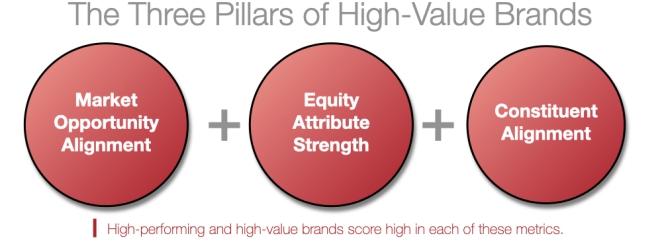It was a fact not lost on George Clooney when he and Rande Gerber started Casamigos Tequila: strong brands are worth more. Casamigos, launched in 2013, sold four years later for a cool $1B netting Clooney an easy $233M. Not bad. The financial value of strong brands gets validated in the market all the time. An obvious example: more than 20% of Apple’s market value is in the value of its brand. Forbes pegs Apple’s brand value at $265.8 billion, and they enjoy an enviable 15.92 price-to-book ratio. And it’s not just Apple, the benefits of a strong brand hold for all companies; the data is undisputed. Strong brands dominate in all respects regardless of product or service, company size/scale, or whether B2C or B2B. Strong brands build wealth.
An analysis by the Marketing Accountability Standards Board shows that “brands contribute, on average, 19.5%, and in many cases, well over 50% of enterprise value when the impact of brand on cash flow, profits, and firm value are properly measured. Superior brand preference in a given category directly improves profitability, price premiums, cash flow, market share, and share price." Research confirms a direct link between brand preference and market share. And a study of 220 consumer products by the Marketing Science Institute found that superior brand preference and reputation commanded price premiums of 26% on average, even when brand quality is the same.
Ok, point made.
High-performance value creation
Private equity has always leveraged financial engineering and operational improvements in value creation strategy. But today, that is not enough to maximize potential. In an increasingly competitive environment and motivated by an appetite for larger returns, firms recognized that financial engineering and operational improvements alone are not enough to maximize return potential. In concert with existing strategies, building brand equity and its intangibles through a defined brand equity optimization strategy is the key to driving outsized returns.
This is how to build power brands – brands that deliver significant equity value and goodwill. While brand intangibles are often hard to measure, the financial power of strong brand equity and goodwill and the ability to improve performance, increase multiples, and maximize outcomes are well understood. High-value brands increase employee productivity, desirability in the markets, and appeal to acquirers. Outcomes across the enterprise improve. When companies commit to brand-focused management and operating philosophy, they generate maximum performance and returns.
A little context is important here: “Brand” is not a logo, a color, or a site design. Brand is a strategy well before it is an expression or tactic. A “brand” is the articulation of a company’s positioning and the extension of that positioning across the enterprise and in the market. Brand is the company. It’s important to keep this straight because brand, when leveraged in this context, contributes exponential value across the entire enterprise.
In an article last year, Forbes called brand-focus ”The New Science of Growth.” For firms that actively pursue high-performance value-creation strategies and strive for outsized returns for shareholders, the contribution to value from brand equity and intangibles can’t be ignored. Brands gain strength over time, delivering sustainable benefits for the business internally, in the market, and, equally importantly, in the minds of acquirers. Strong brand equity and goodwill dramatically strengthen negotiating leverage and the promise of future success — always a positive multiple modifier. Strong brands mitigate investment risk and inevitably improve outcomes.

Understanding this, private equity firms, like general businesses have become believers. More and more firms are committing to optimizing portfolio brands’ intangible equity value by making brand equity optimization a complimentary best practice for active portfolio management. Brand strength has found its rightful place in value creation strategy.
Building high-value & high-performing brands
Three pillars are found in all high-value and high-performing brands: strong constituent alignment, strong intangible brand equity attribute strength, and strong alignment with market opportunity. Each pillar contributes to and has an integrated relationship with the others. Employee, market, and investment performance is amplified and accelerated when these three pillars are aligned and optimized.
To build high-value brands, all the attributes within each pillar are prioritized and optimized. Evaluating brand strength within this construct ensures the proper rigor when assessing strengths and weaknesses used to identify strategic and tactical opportunities for improvement. Is every employee aligned with the brand’s position? Are all brand attributes being nurtured through superior customer experiences and a uniquely differentiated product or service? Is the overall brand (company) positioning aligned with the current market dynamics, trends, and opportunities to maximize potential? Companies thrive when all value pillars are performing to their maximum potential. The three pillars of high-value brands:

1. Market Opportunity Alignment
All positioning decisions for any brand must first align with market opportunity and competitive dynamics. Market dynamics change in a heartbeat, especially when tech is involved. Everything about a brand’s positioning and intangibles must align with a defined and sustainable opportunity while also aligning with business and stakeholder objectives. Proper brand positioning forces a focused articulation of a brand’s market context, an understanding of its audience, its unique selling proposition, and its support for that proposition.
No brand can survive without a well-defined positioning that is specifically aligned with a market opportunity. Is the brand positioned in a competitively unique way? Is the positioning believable and supportable? Are there competitive threats? Is the company’s organizational structure aligned with what the company must execute to scale? Is there an identified market opportunity to scale? Is it sustainable? What about products? Feature sets? Is the customer experience what the market expects? Is it what customers want? Is the value proposition being properly extended in communications? What about brand purpose? Answering these questions, among a host of others, is necessary to ensure a brand is properly aligning with market opportunity.
2. Equity Attribute Strength – Love & Other Intangibles
All equity attributes, tangible and intangible, must align with and support a brand’s positioning. Tangible and intangible brand attributes contribute directly to market performance and enterprise value. How strong is employee satisfaction, employee retention? How well aligned are employees with the company’s mission? How strong is the brand perception in the market, is it aligned with positioning? What about brand loyalty? Purchase intent? Is the brand image reflective of the positioning? How about customer retention? Advocacy? Social strength? Brand appeal?
Assessing the strengths or weaknesses of equity attributes reveals opportunities for strategic and tactical remedy to improve alignment, amplify value, and accelerate performance. Establishing baseline brand attribute strength and incorporating ongoing monitoring is advisable for continuous improvement. When equity attributes are strong internally and externally, brand value is high, performance improves, value increases.
3. Constituent Alignment & Consistency Over Time
The importance of brand alignment and constancy of a brand’s extension and expression across all constituents cannot be overstated in building high-value brands. It is critical. To build high-value brands, all constituents must be aligned and singing from the same song sheet. A well-strategized and articulated brand position and strongly aligned equity attributes provide the roadmap for building brand value.
Growing equity value in a brand requires tight consistency over time, with every constituent understanding the brand and its value proposition. Every point of customer touch has to reinforce the brand position. Building strong constituent alignment considers a wide range of brand attributes to ensure they are well understood and aligned across leadership, management, employees, customers, and in the market. Do all constituents clearly understand the brand’s positioning, offerings, and differentiation? Is the brand’s position properly articulated in communications, internally and externally? Are sales and marketing aligned? Are the company’s brand vision and purpose understood, consistent, and aligned with positioning? What about its brand purpose and values? When all brand attributes are aligned across all constituents, organizational and operational performance improves exponentially.
With all three pillars aligned and performing with one understanding and one voice, business finds another gear, and value inherently grows. To optimize these pillars, companies should use an assessment approach that allows for global and granular analysis to evaluate alignment. For private Equity, active portfolio management requires a nimble approach that facilitates making tangible changes and improvements to these three pillars quickly and on the fly. The process should not be cumbersome or time-consuming, bogged down by lengthy and expensive primary research. The most effective approach for assessing intangibles is with objective thinking unencumbered by any vertical domain bias or confirmation bias often found in self-evaluation. It requires distillation, simplification, and clear prioritization based on goals and budgets. You want your assessments of these pillars to lead to insights and opportunities for immediately actionable strategies and tactics to improve performance and build value.
TEN THINGS TO REMEMBER WHEN BUILDING HIGH-PERFORMANCE BRANDS
All companies, both B2C and B2B, that embrace a brand-driven approach enjoy tangible competitive and performance advantages. For private equity folks, building brand has become a best practice delivering wide-ranging benefits, not the least of which include increased sellability, larger transaction multiples, and outsized returns for investors.
A few things high-level considerations when building your high-value brand:
- Embrace being brand-focused as a philosophical approach to how you do business. Align leadership and management with this directive.
- For private equity, brand equity optimization is a standard best practice to build shareholder value. In concert with financial engineering and operational improvements, make it the way your firm does business.
- Commit to assessing and optimizing brand performance from day one. Brand equity and its financial returns grow exponentially over time.
- Be consistent and don’t waver, put your stake in the ground. Strategy when done with rigor, should be sustainable. Consistency over time is the name of the game.
- When considering acquisitions, add brand evaluation to the pre-diligence process. Often, at the deal stage of diligence, it is too late. Brand evaluations provide a critical added layer of evaluation to reduce risk.
- When considering bolt-ons or mergers, assess brands for alignment with business objectives, additive benefit strength, and cultural compatibility of the brand as part of pre-diligence.
- Brands grow over time and require nurturing and maintenance. Consider regular brand assessments over time as an operating philosophy of continuous improvement.
- All brand attributes must align with business objectives and market opportunity. A strongly perceived brand that is not aligned with the market nor in line with stakeholders’ goals is not a strong brand. Particularly relevant when considering exit strategies.
- Few things are more important than a company’s core constituent’s consistent understanding of a brand’s positioning and value proposition. The alignment of people is everything. That one drummer thing again.
- For startups and early-stage companies, it’s imperative to take a market-focused approach in developing brand/company positioning. Do it from day one, ideally before series funding begins. You will reduce your risk and reduce your cost of capital. Unfortunately, many early-stage businesses do this way too late.
Brands are magical things. Both tangible and intangible, rational and emotional. Strong brands significantly influence consumers and buyers of businesses alike. Consumers and buyers will always make both rational and emotional decisions. The final decision is always emotional, and all those intangible brand attributes are significant drivers of that decision. For an acquirer, a high-value brand indicates low risk and a high likelihood of future success. Just what acquirers want.
And why you want one.
***





Al April 15th, 2023, in the morning
Anheuser-Busch just lost over $6Billion in a week so you know what not to do.